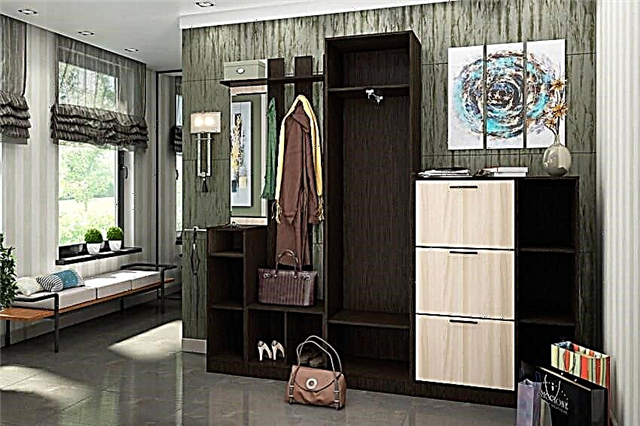Equipped room in the attic can significantly expand the living space of the house. Often the attic floor turns out to be the most comfortable room in the house and subsequently is reserved for a children's room for games, a living room, and sometimes even a bedroom. The ideological inspirer of the technology for arranging the space between the ceilings and the roof of the house for a living room is the famous French architect F. Mansard (his name has since been the term that defines this space).
Preliminary work and planning nuances
Before making a room in the attic, the landlord must decide what kind of room he wants to equip under the roof. After that, you can start planning. If the attic in a private house is not available at all, then attaching the attic will be a priority.

Optimal attic height
If it is available, it is worth considering the optimal height: if it does not reach two meters at the very minimum point, the roof of the attic floor must be raised. After raising it, on the floor there are low extended walls (about 1-1.5 meters), which makes the room more comfortable for life.
Only after the height is optimal for a normal living room, you can proceed to the second stage of development.
The main stages of work
Joining an attic with your own hands is impossible without building a staircase. Usually the staircase is located in the corridor or hallway of a private house. The best performance material is wood, because it is durable, environmentally friendly and decorative.

Stairs to the attic
At the second stage, you need to equip the windows in the future room. If the window is located not in the extended wall, but in the roof, it is worthwhile to make a strong wooden frame for it, able to stay in the roof and withstand the load of precipitation falling on it (snow or rain). The gap formed after installing the window between the window frame and the wall or roof must immediately be insulated with your own hands.
In the next step, the attic room should be equipped with a frame. Both the walls and the floor of the future room are sheathed with a frame. In addition, a heater is placed between the crate and the casing. At the same stage, electrical wiring and electrical components are laid, after which it is worth carefully considering the location of outlets and communications in order to make holes for them in drywall with your own hands.
The last step is the decoration of the room, which takes place in several steps:

There should be no gaps between the window and the wall
- installation of drywall plates (for a stronger fortress, a second layer of drywall may also be required),
- plastering and sealing of slopes and cracks between walls and window and doorways,
- Strengthening joints and masking joints between plasterboard sheets.
Despite the fact that the conversion of the attic to a room, at first glance, seems quite simple, each of the stages of work has its own nuances, especially with regard to the thermal insulation of the attic floor.
Attic insulation
This is the most responsible event for equipping the attic room with your own hands, because heat losses through the roof of the house, without proper thermal insulation, are enormous.
The following materials are suitable for attic insulation:
- Polyurethane foam,
- Styrofoam,
- Mineral or stone wool
- Expanded clay (they only insulate the floor of the attic).

In the process of attic insulation, the following stages can be distinguished:
- arrangement of the lathing (installation of ceiling beams on which the floor is laid),
- laying in the intervals between the beams of the selected insulation,
- if you choose polyurethane foam, it is enough to blow it out in the gaps between the beams, without preliminary laying the waterproofing, because this material repels water well,
- if mineral wool or expanded clay was chosen as a heater, it’s worth doing it yourself to lay a plastic waterproofing film under the material,
- the final stage of attic insulation is the arrangement of the floor on the finished crate (for this purpose, plywood sheets can be used, although the best option is ordinary boards pinned to the floor slabs).
Decoration and decoration
After the thermal insulation of the floor in the attic is successfully completed, you can proceed to the assembly of the room box. It is assembled from bars covered with crate and lined with lining. Between the bars of the box, a heater is also laid.
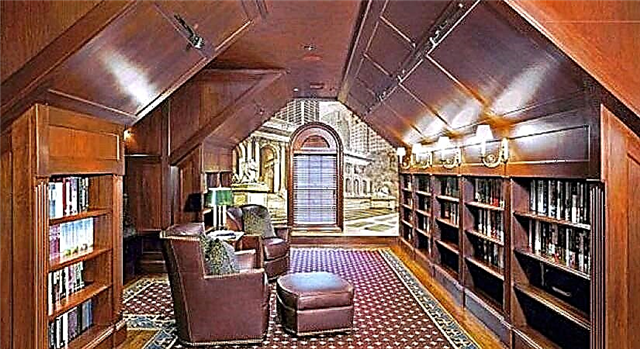




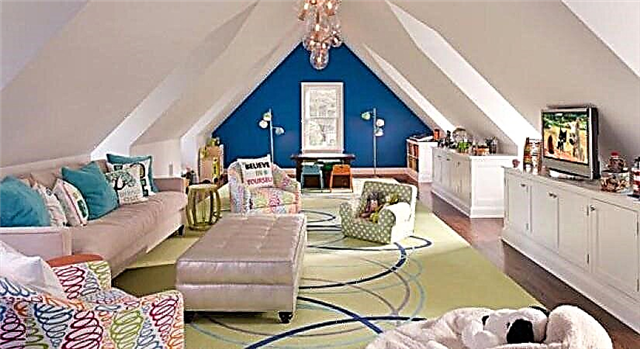
After the box of walls is sheathed with sheets of drywall, you can proceed to further decoration and decoration of the room.
First of all, you need to figure out which room will be there:
- children's play room (in the children's room, as in the bedroom, warming is of paramount importance),
- library,
- gym,
- recreation area: billiards, for example
- workshop,
- utility room or dressing room,
- bedroom (in case there is not enough living space in the house), etc.
In fact, the attic space can be equipped completely for any room, including even a bathroom or kitchen. In addition, the space of the attic floor of the house can be spent even more rationally and even divided into several zones and allocated for each separate room.

If you equip an attic for a nursery or office, you need to worry about quality lighting: the windows in this case become large. The location of the desk is determined by the location of the window.
Location in the attic does not dictate any special design of both the children's room and the study: it can be the same as in ordinary rooms.
Arranging an attic for an office is a great idea for those who, on duty, have to work a lot at home at the computer. The attic floor will be the quietest place, allowing you to concentrate on work without being distracted by various annoying factors, whether it is a washing machine, vacuum cleaner, children's cries, etc.
Even during the time when the attic will be connected and the planning of further practical use of the floor, it is worth thinking about lighting. Ordinary chandeliers for a gable roof, of course, are not suitable, but lamps installed on walls or roof slopes are perfect. It is better to install several lamps in different places.
If you are confused by wooden beams, then they can be camouflaged with sheets of drywall. Most often, the owners leave them in sight, finishing as a stylized detail of the interior.
However, if you do not want to come up with any special design for the attic room, it is quite possible to equip it in the same style as the rest of the rooms in the house.
Cold Attic - How to Make It Residential

The first thing is to warm the attic space
It should be noted right away: a room that is comfortable in every sense, comfortable for a stay, you will be able to get only when there is an area of sufficient size.
Finishing the attic usually begins with the fact that the owner understands that he has a cold space, which somehow needs to be made residential. When the attic is insulated - it can be called a completely finished room, here you can live or do some business.
The responsible task is to finish the attic. The main work here is the implementation of measurements, inspection of load-bearing structures, existing coatings. It is important to ensure that the beams are in good condition - especially in the immediate vicinity of the exterior walls.
Just sometimes water leaks - and the beams begin to rot. If you find something similar in the attic, the amount of work will increase significantly..
- When rotten beams are found, the master must replace them,
- Also, the flooring should be examined very carefully, like the chimney, other parts of the structure,
- The attic will be a wonderful room if the height of your under-roof space is not less than 220 cm (the extreme limit is 200 cm).
At the inclined part of the ceiling vertical wall should be at least 160 cm (100 cm is the minimum size allowed).
We warm the attic - an important stage of work

There are different ways to warm
Let's consider two options, with which the attic can be insulated:
- They immediately insulate the entire roof - due to this, you can also get a tangible increase in useful area,
- A warmed room is built into the free attic space.

Each of them has its advantages and disadvantages.
Both the first and second options have their pros and cons. If you get extra space - it will not look quite neat - and putting it in decent form is not so simple.
And the secondary building will “hide” a significant part of the usable space - it will not come out very large. However, in terms of design, such a solution is simpler and more accurate - this is a plus option.
You can always use the alternative - just combine two options at once. It is also possible to insulate the attic easily with your own hands - today enough modern materials are on sale for this.
Thermal insulation is carried out in accordance with the following recommendations:
- Wooden structures that the master is going to insulate must be pre-treated with special antiseptics. All problem areas must be repaired - it’s impossible without it,
- If there is a waterproofing, before starting work, it is worth checking its integrity. If you identify problematic, damaged places - they need to be restored. A repair tape will always help with this,
- When reconstructing the attic, one must remember: the flooring regularly experiences atmospheric changes. Because of this, the need for repairs is increasing. So it’s worth providing free access to these elements - so that if necessary it would be possible to make repairs without unnecessary trouble.
Stages of warming

After the insulation, you can finish the attic like this
So that in the process of finishing the attic perform also warming, usually act like that:
- Between the rafters, the space is filled with one or another heat-insulating material - accuracy is important here. If the layer thickness is insufficient, it’s worth laying an additional layer on top,
- Make sure that the joints of the insulation overlap, while they should be perpendicular to the "legs" of the rafters,
- Bulk material is used to insulate floors,
- It is important to lay the insulation layer without any dips, dents - swelling should also be avoided,
- Close attention is paid to the nodes that are adjacent to the walls and roof. It is necessary that the outer walls get insulation boards.
The attic has another problem area - the place where the windows and the roof are connected. Insulate the window slope in the attic at a right angle to the surface of the window - then smoothly switch to the slope.
- Another difficult area is the place where smoke and ventilation ducts intersect. It is customary to insulate these places with mineral wool (only non-combustible material is used!), Installation is carried out without gaps and voids - this is important,
- Without a layer of vapor barrier, thermal insulation is never complete. The task of this material is to make sure that the insulation does not humidify. This happens because of the water contained in the form of steam in the air,
- The installation of vapor barrier tapes is made with a mandatory inlet - 10 cm is enough. Fastening can be done with simple tape. Stacked layers of materials will be securely covered by the inner lining.
Consider the following point: such insulation as mineral wool (especially, if we talk about glass wool), on unprotected skin cause irritation, itching. When working, use eye protection and respiratory protection!
The following points will also be useful to you., if you decide to work with the improvement of the attic:

Thermal insulation - protection not only from the cold
- Thermal insulation is needed not only to protect the room from the cold. She copes well with overheating - when it's hot outside. So the calculations should be done very responsibly, for sure. On the outside of the roof, a heat-insulating layer is attached - so that the moisture erodes under the influence of air. We are talking about the moisture that forms on the underside of the roof from steam condensation,
- Thermal insulation is also required for cornice masonry and the partition, which is available in the attic. Here it is needed so that there is no “bridge of cold" - a fairly common phenomenon in many regions,
- The vapor barrier is usually selected depending on the purpose of the room. A bathroom or kitchen, where the moisture content is high, needs an insulating layer - especially when the roof is made of sheet steel or tiles (that is, it is not able to let steam through),
- If there is not enough natural air ventilation, you will have to use an electric fan - it will help ensure optimal performance,
- Separate rooms, which are equipped in the attic, usually provide special longitudinal ventilation. For this, ventilation grilles are installed along with the blinds. In winter, they close (sometimes between the roof and the room sheathing) leave gaps - so that the air can circulate without problems.
In the attic, the living room is real
What should be the living room if it needs to be organized in the attic? There are rules and features. All communications should be below, they should be located correctly. The capacity of the water supply system, the general condition of the pipes, the ability to connect to existing communications plays a role.

To create a living room in the attic is more than real
If it turns out that the water pressure is insufficient, it will be necessary to install a more powerful option, which requires additional investment. In a word, everything is not so simple. You can watch the video - finish the attic yourself in a private house. Surely, this material will be useful, informative.
What else to know about the attic room?
- At the planning stage, it is usually taken into account whether it will be easy to join those pipes that lie on the lower floor. Sanitary units, bathrooms - they are usually made so that they are located strictly on top of each other - precisely for the reasons stated above,
- If we take into account the gas pipes installed in old houses, then everything is not simple: there may not be the right sizes. We will have to carry out a replacement, to modernize what is. However, there are positive aspects to this: you will be able to put a boiler for heating, install a gas water heater and much more.
To complete the construction, the lightest materials are usually selected. The main thing is that their installation was possible dry. Otherwise, the rafters will simply bend - the load will be excessive.
- In the attic, the floor is made easy - this is very important. So, the old boardwalk needs to be removed, bulk slag or slag concrete also must be removed. The floor is laid on a light foundation, which should be warmly soundproofed,
- In order not to make the structure heavier, it is customary to make partitions light - so that they can be placed on beams. The practice is this: the frame is made of bars, which are fixed to the bars using pads or spikes - they are fixed to the coating structure,
- The distance that exists between the racks of the frame determines the dimensions of the plates. Plates can be made of different materials - partitions made of panels are practical.Made in advance, then nailed to the floor and ceiling,
- To finish the attic in the country house turned out to be excellent, you don’t need any special devices when the ceiling is arranged - they are made simple, light, usually made of wood,
- Thermal insulation is placed on the ceiling beams (sometimes with puffs). Clay or concrete coatings cover the upper side of the ceiling. The thickness of such a coating should not be more than 30 mm. This is important in terms of fire safety,
- The staircase to the attic is most often made of wood. The height and width of the steps effectively compensate for the lack of space, the march width here also plays an important role.

It’s necessary to work on the floor properly - in the attic its quality is of great importance
Do not install bulky, heavy furniture in the attic. This simply cannot be done - and it will not be easy to raise such things there.

Relaxing in the attic can be very enjoyable.
If trusses are used as supporting structures, then the partitions are well placed near them. On the one hand, the farm is sheathed with plates, on the other - you can put a bookshelf or some other. You can choose, for example, a shelf for some souvenirs, storage of collections and so on.
Slanting farms that have been varnished, painted, stained will definitely not ruin the look. Just look at the photo, the attic trim will look with elements such as "Antique".
- If the partition provides for a door so that you can move from one room to another, steps are made over the puff of the farm. In front of the door, the width of the step is usually 400 mm.
- The interior of the room will be architecturally expressive if its length is two steps of the farms. In the middle, on a puff of a farm, they put a shelving partition - here you can install a TV or store books. You can also arrange a bar with drinks - a common reception,
- Someone attaches two small ottomans (or one ottoman, which successfully combines with a bookcase or low cabinet),
- In such a room, lighting will be done using dormers. In the plane of the roof there may be inclined windows. Also, in the gable wall you can cut through the windows - they do it regularly,
- The downside of slanted windows is that they are difficult to clean, and they do not transmit light in the best way. Moreover, in winter they are often swept by snow, and in the summer it is not easy to curtain such windows - because of this, it is often hot in the attic,
- Above the windows of the lower floors are dormer windows. Sometimes this is done symmetrically (relative to the center) or right in the center.
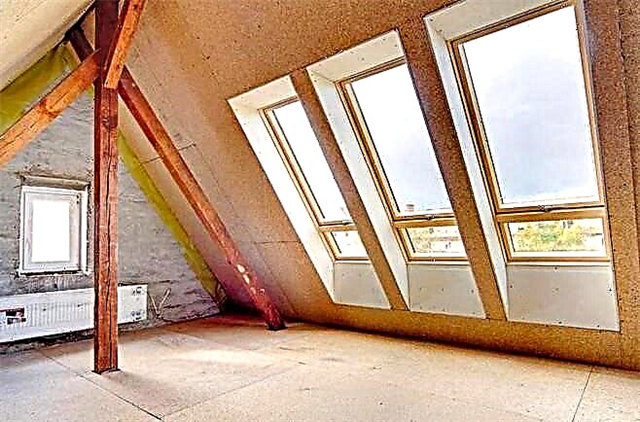
Studio, children’s, games - all this can be organized here
It is better not to violate the architecture of the building - any instruction will confirm this. Please note: the easiest to manufacture can be called dormers. Install them directly on the rafters.
There are no strict restrictions on the decoration of the premises. It is necessary to putty, paint, wallpaper the walls, make the cladding with some kind of material - it all depends on what the owners themselves want.
Usually, they are guided by the cost of certain finishing materials. Combinations of all these solutions are also not as rare as it might seem - people love diversity.
Rating: 5/5, total ratings: 6
How to make a residential loft
We make a reservation - a comfortable room can only be made in an attic of sufficient size, both in plan and in height. In addition, we will talk about a cold attic, since the insulated attic is essentially a finished room.

Residential attic room in the attic
From the foregoing, it is obvious that in order to get a comfortable room we will first have to provide its insulation and you can find out more about this on this page. And here you can go in three ways:
1. to insulate the whole roof,
2. integrate the insulated room into the free space of the attic,
3. a combination of the first two options.
The first option will give us a significant usable area. In turn, the second structural solution is neater, but the room will turn out to be small.
Installation of the lining of the attic insulation
The third option, as often happens, lies in the middle and is a combination of the first two options. What can be visualized with the help of Figure 1.

Attic room options
Where possible, on the roof slopes, we insulate the roof itself. If required, we mount on slopes an additional frame made of galvanized profiles. With roof insulation min. with cotton, it is necessary to leave a ventilation gap of 40-50 mm between the roof and the insulation, or rather waterproofing, which must be laid before the insulation. From above and from below along the edges, using galvanized profiles, we assemble the frame and sheathe it with GKL sheets, laying heat insulation inside. How to work with drywall, you can find out on the link. Drywall is better to take moisture resistant (its sheets have a characteristic greenish color with blue marking).
Since the external wall sheathing serves only to protect the insulation, thin GKL or OSB-3 can be used for it. From the inside, you need cladding with GKL sheets of 12.5 mm thickness (preferably double). Or OSB-3 with a thickness of 14 mm.
The thickness of the insulation (it is better to use a semi-rigid min. Slab) in the wall of the future attic ranges from 100-200 mm, depending on the region.
Before installing the casing, the insulation must be protected from possible moisture. To do this, we lay a film vapor barrier from the inside, and a hydro barrier from the outside. A vapor barrier will prevent the moisture contained in the air from entering the heater, and a hydro barrier will protect the min. cotton wool from accidental ingress of water from the outside, will allow water that nevertheless gets on the insulation to evaporate freely.
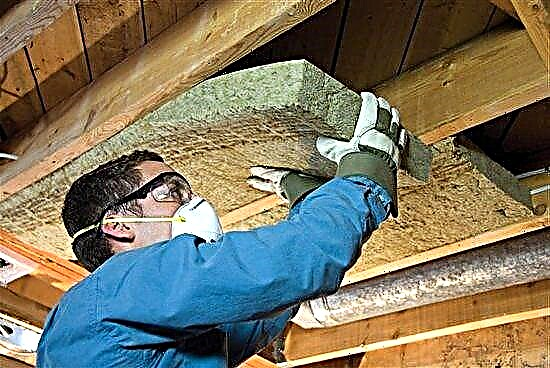
Roof insulation is a prerequisite for the installation of a living room in the attic.
How to make a living room in the attic with your own hands (an example of insulation)
Consider an example of the device of a living room in the attic, or rather its insulation. In the photo below, the main frame for our insulation is already formed by rafters, crossbars and roof racks.

Roof construction: crossbars, racks, rafters
To save space, behind the racks (and not in front of them) at the bottom we mount parallel to them vertical racks of bars or galvanized profiles. Between the profiles horizontally mount galvanized profiles for gypsum board or bars, with a section of 30 * 40 or so. We fix the bars on metal corners, exposing horizontally with a level. We cut the profiles, it is better as shown in the figure below, and fasten them on the screws horizontally to the bars. The distance from the front to the rear pillars is selected by the thickness of the insulation.

We are assembling the frame of the back wall, it should turn out something like that shown in the figure below. We assemble the frame evenly, observing the lines. If it works out a little crookedly, there’s nothing particularly terrible - this is the back wall, you will never see it again and no one will look at it, at the same time you can practice (if you don’t have experience), fill your hand a little to the front side.
Rear frame for attic insulation
To smoothly expose the frame, from below we are guided by a long straight rail, or we beat off an even line on the floor with the help of a chopping cord.
Next, we sew up our back frame with drywall 9.5 mm thick, or OSP-3 9 mm thick.
Next, go to the top of our attic, the future living room. First, it is necessary to increase the existing crossbars up to the thickness of the future insulation. This is necessary for the convenience of laying the insulation and fixing the waterproofing over the insulation. To do this, we fix on top of the crossbar boards or bars of the required dimensions along the length of the frame, as in the figure.
Between the crossbars we mount bars or a galvanized profile for GCR. At the bottom, all elements must be in the same horizontal plane.

Schematic representation of the lathing for insulation
The upper part of our living room in the attic must be insulated in parts, sewing openings one at a time. Having built the frame, we sew up the sections one at a time (for convenience) with sheets of gypsum board or OSB, we put vapor barrier on top (it is necessary that the vaporous moisture from the room does not fall on min. Cotton wool) and then thermal insulation. Thermal insulation sheets must be laid close to each other, it is better to lay in 2 layers, overlapping the seams of the previous row. If we use min. cotton wool, over it we lay a vapor-permeable waterproofing, nailing with brackets of a construction stapler to the extended crossbars.
Thus, one at a time, we build all sections.
It remains to insulate the roof slopes. If we use min. vatu, then do vent. clearance, for which on met. corners we fix the crate from the boards so that between the roof and the crate there is a gap of 30-50 mm.
Next, you need to fill extra. the frame on the rafters, by analogy with the upper part, so that there is an opportunity and a place for laying insulation. We select the width of the boards so that the insulation fits tightly against the wall structures, but does not squeeze much.

We fill the waterproofing along the crate, which allows vaporous moisture to pass out (for min. Wool), preventing the penetration of the liquid phase. We lay the insulation, vapor barrier on it and we sew it with drywall or OSB.
The bottom is left. By analogy, we arrange horizontal lintels, lay the thermal insulation inside, vapor barrier over it (when using min. Cotton wool, oh this min. Cotton wool) and we sew it with sheets of gypsum board or OSB.
DIY attic heating
We have insulated our residential attic. But warming without heating will not work, therefore, heating in the attic needs to be taken care of. It will be electric heaters, or you have a boiler, from which you conduct water radiator heating in the attic - you decide.

Attic heating radiator
Attic floors
Another important point is the installation of the floor. If the rough floor already exists - good. And maybe not good, because under it you can hide communications, the same heating pipes and electrics. If there is no rough floor, you can first make an electrician and heating, then take care of the device of the floor in the logs, if the floors are wooden. Insulation of the floor, if the attic is residential, is not required, but if it is already there, it is not necessary to remove it.

Attic floor, attic floor
How to conduct electricity in the living room in the attic
How to make a room in the attic, we examined. Now you need to conduct electricity into it. There are several ways to do this. The easiest and most convenient way is to lay wires on top of walls in plastic mounting boxes and baseboards. True, in this case, the boxes will be visible, but there's nothing to be done. In addition, they look quite neat.
You can arrange hidden wiring by laying the wire directly under the inner lining. At the same time, fire safety requirements require that the wire be previously placed in a special corrugated sleeve.

Wiring can be hidden in a plasterboard partition
Attic living room decoration
It remains to complete the finish. Here, there are no restrictions, you can putty and paint, you can wallpapering, or cladding. You can combination of all of the above.
Of course, before the construction of the room itself begins, it is necessary to provide access to it by cutting a passage in the ceiling and installing a staircase. How to make a ladder can be found here and here.
As for the questions that may arise during the work, you will learn the answers to them from other materials on the site. For example, how to make wiring, or install sockets and switches.
Leave your tips and comments below. Subscribe to the newsletter. Good luck to you, and good to your family!
Features
In order to correctly and beautifully design a living room in the attic, it is important to take into account the specific features of this type of room. They can relate to both the visual design of the room and practical convenience. In addition, it all depends on the size and layout of your attic, as well as on the specific situation of the room that you plan to place there.
First of all, the attic can be warm or cold. If you have an insulated roof, brick house and heating, the temperature in the attic will probably be comfortable at any time of the year. If the house is wooden or there are problems with heating, you should think about how to additionally insulate the attic.
The roof can be finished with mineral wool, polyurethane foam, sawdust or felt. This will create a barrier to cold air.
Also, for insulation in the room, you can place a conventional heater or a decorative fireplace, make a heated floor, or simply supplement it with a soft carpet.
Most often, the attic is a small room, although there are exceptions. Since there is no physical possibility to alter the layout and expand the room, it is worth choosing design solutions that contribute to the visual expansion of the space:
- First of all, it is worth choosing light colors and glossy textures.
- It is recommended to avoid small parts.
- Also, you do not need to purchase any decorative accessories and extra furniture in advance. It is important that you are comfortable walking around the room, sitting in an armchair or at a table. The functionality of things in the attic room should come first.
- Pay attention to the entrance. In spacious rooms there is the opportunity to build a semblance of a corridor and a door. However, if the attic is completely miniature, the staircase may go directly into the room. This is not a very significant difference in the attic room, but it is important that the entrance is convenient.
If you have a steep spiral staircase, make sure that the space around it is free (without furniture that impedes access).


The specifics of lighting in the attic will depend on whether you have windows on the roof and how large they are. If there are no windows, this room is unlikely to be comfortable as a nursery or living room, however it is quite possible to make a small bedroom or study out of it. It’s good when there is at least one small window in the attic. Additionally, you can place several light lamps that provide adequate lighting.
Modern houses often make panoramic windows that cover a substantial part of the roof. This perfect solution will make the room especially pleasant and cozy, however, if you equip the attic under the bedroom, you will need to take care of the curtains or blinds.
The height of the ceilings will also play an important role when considering a floor plan. If the roof is very low, such a room is best used as a bedroom (it is unlikely to be suitable for something else). Can be done in the attic with a low roof and a nursery, but when the children grow up, redevelopment may be required.
The ceilings in this part of the house almost always turn out to be slightly lower than in other rooms, but if you can easily sit in a chair in the attic, it will be suitable for almost any room.

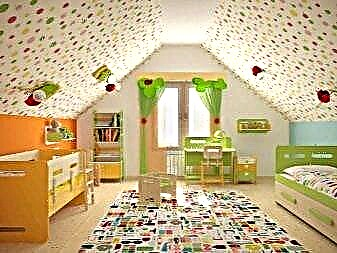
Appointment
There are many ways to equip the attic in the country or in a country house for living space. It all depends on your needs and the layout of the rest of the building. It can be a nursery, bedroom, study, living room or any other room that you need.
Let us consider in more detail the most successful design options for such a room.
- In an attic apartment building, many place a bedroom. This is a great option, as attic ceilings are usually low and windows are small. Thanks to the triangular roof in the room, you can create a unique interior with a special atmosphere. Especially relevant options in the Provencal style or in the style of country.Even if you have a very small attic, it is quite possible to equip a bedroom, because this requires a minimum of furniture. For the most concise room, a low bed and a pair of nightstands with lamps will suffice.


- When determining the best attic destination many decide to take him to the nursery. Indeed, there you can create a cozy place by placing beds for children, toys and even allocating a place to study. However, in this case, it is important to take care of good attic lighting. In addition, steep stairs that lead directly into the room may be unsafe for small children. Therefore, if possible, it is better to make a symbolic entrance hall and a separate door to the children's room.

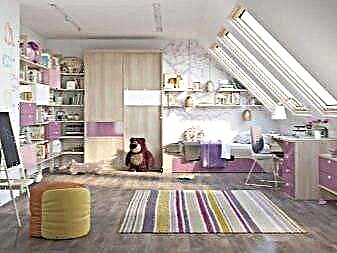
- Can be done in the attic and living room. It can be single or optional if you have a large family. Armchairs, a coffee table and a TV are all that is needed for this room. To give the interior an unusual look, you can consider lighting with colored LEDs, decorative beams or large carpets with a long pile. The attic will be a pleasant place to meet friends or family conversations, board games and watching movies. Well, if there is the opportunity to make a large window, because it is from the attic that it is best to admire the stars.
- If you need a separate room for working at homeYou can equip it in the attic. Such a room is called an office. There you can enjoy the peace and working atmosphere. Even in the smallest attic you can easily place a desk and chair. The big advantage is that the attic is largely isolated from the rest of the house, so even if you have a large family, you can expect that you will not be disturbed here.


- Art lovers often make an attic studio for their hobbies. If you are passionate about painting, you can place easels there without fear of staining paint, walls, floors and furniture in the rest of the house. If you make music, you can make good soundproofing in the attic by upholstering the walls with felt. So you can do what you love at any time of the day without disturbing other family members.
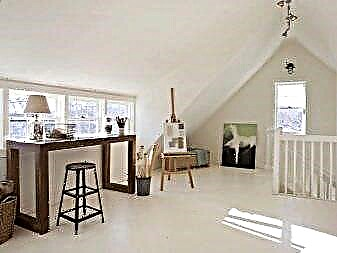

- If you like books and put together a large collection, the attic may well serve as a library. It is enough to put a few racks, a couple of chairs and a coffee table. The attic of a private house can become a quiet and comfortable place, ideal for relaxing with a good book.


Style and Design
The design of the attic may be different - it all depends on the style of the interior of the house, as well as on the purpose of the room. In some cases, finishing can be done with your own hands, however, the implementation of some options may require the help of specialists. For example, lighting problems often arise if several fixtures are planned. It is also difficult to independently make the installation of false ceilings or floor heating.
More simple design elements of the attic can be quite budget. But before deciding on the design, it is important to choose the style of the room.


Often, wooden or even brick country houses are decorated in a country style. Village aesthetics allow you to feel yourself a part of nature and surround yourself with pleasant natural materials (mainly wood is used in decoration). The country-style attic ceiling can be laid out with clapboard and beamed. The decor of the walls and floor in this case is usually also made of wood. Textile and leather elements, as well as long-pile carpets imitating animal skins, can organically complement this design.
If you want to bring romantic notes to the interior, you can opt for Provencal style. The simple and refined interior of a French country house implies a light color scheme, a combination of wood, metal and textiles. You can paint the wooden walls, floor and furniture white, select several accessories from brushed metal, as well as use checkered or floral fabric for curtains, tablecloths and pillows.
Modern look attic finishes in the Art Nouveau style. For the attic window, you can choose a mahogany frame, decorate the walls with textile wallpaper, and decorate the space under the roof with a massive chandelier. This is an excellent option for arranging a bedroom or living room. It will be quite easy to choose furniture for such an interior, while it is not necessary to maintain the whole house in a strictly unified concept, because modern can be interestingly combined with neoclassicism and eclecticism.
The attic room can be equipped even in a minimalistic high-tech style. It is good if the area of the room on the top floor is spacious enough, because modern design gravitates to large spaces. As a floor covering, you can choose tiles or laminate, and the walls can be simply painted. Glossy furniture will fit perfectly into such an interior; several lighting sources are desirable. A combination of different textures will be successful (for example, metal and wood can look very interesting together).


